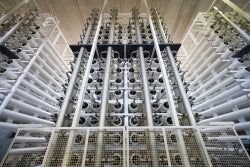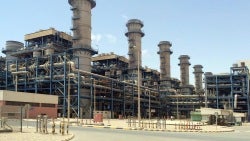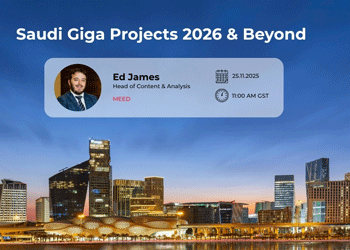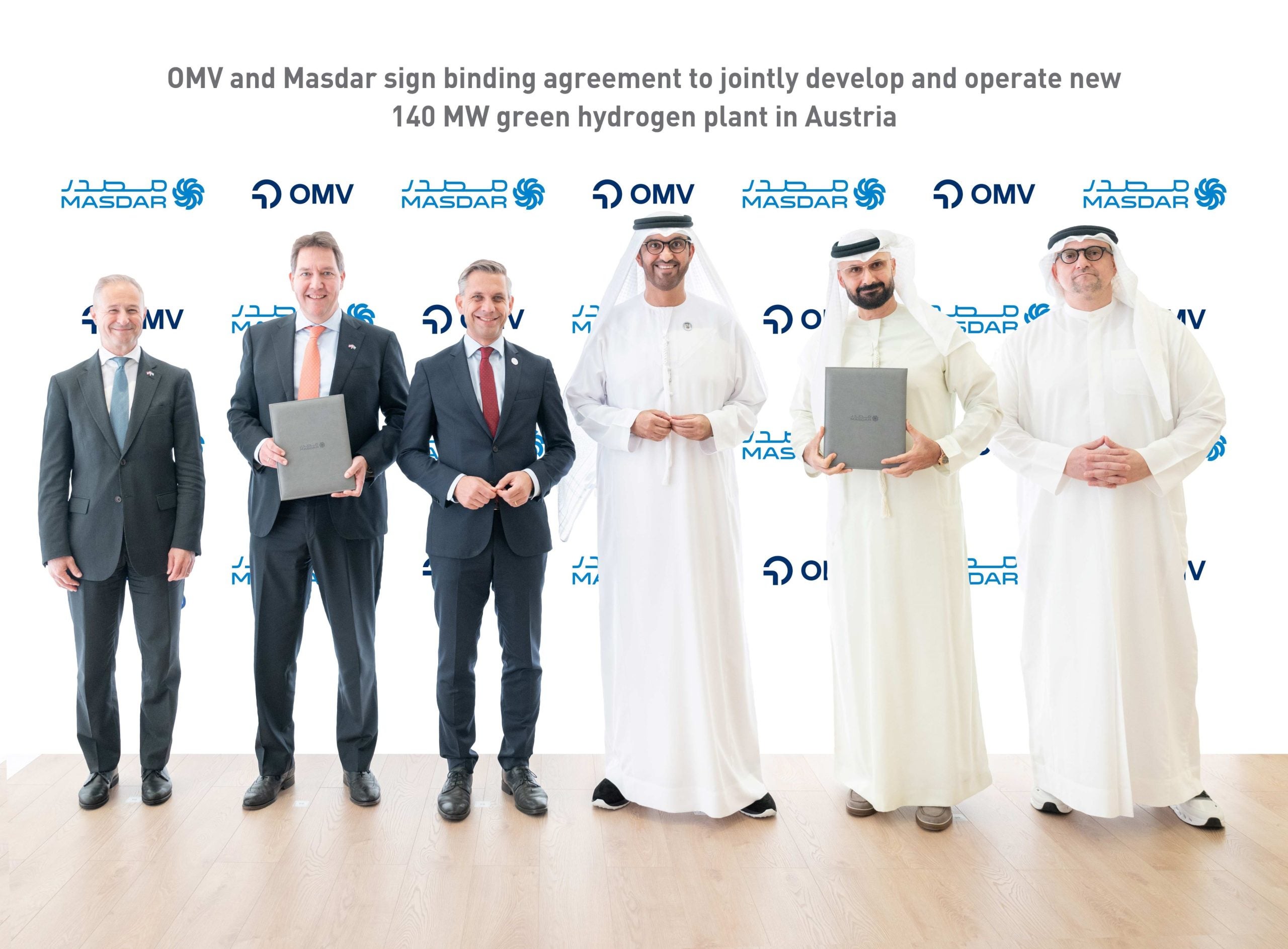The way forward for the region’s energy transition
12 December 2022
Published in partnership with

Whichever way one looks at it, the world faces a climate emergency. In its most recent multi-agency report published in September, the World Meteorological Organisation (WMO) warns that there is an almost one in two chance that the annual mean temperature in at least one of the next five years will be 1.5°C higher than the 1850-1900 pre-industrial average.
This figure is important because it would breach the maximum temperature rise set by countries under the terms of the 2015 Paris Agreement and underlines the lack of progress in reducing harmful emissions.
“Floods, droughts, heatwaves, extreme storms and wildfires are going from bad to worse, breaking records with alarming frequency,” said UN secretary-general Antonio Guterres in the report.
“Heatwaves in Europe. Colossal floods in Pakistan. Prolonged and severe droughts in China, the Horn of Africa and the United States. There is nothing natural about the new scale of these disasters. They are the price of humanity’s fossil fuel addiction.”
There are multiple ways to reduce global greenhouse gas emissions, with a common thread among them being using technology as a solution.
Whether by making gas turbines more efficient, producing new low-carbon or carbon-free fuels such as hydrogen, increasing renewable energy output, or ensuring homes, towns and cities are ‘smarter’ in their use of electricity, technological innovation presents a means for countries to lower their carbon outputs.
All [the reports] stressed we are not on track to keep climate change below 2 degrees, or even keep the 1.5 degree target within reach. More work needs to be done
Mohamed Nasr, Egypt's lead negotiator at Cop27
Scale of the problem
In the series of six articles MEED has published in association with Siemens Energy, we have explored the chief challenges the Middle East and Africa regions are facing in the fight against global warming and some of the opportunities and potential solutions to overcome them.
The first hurdle is recognising the scale of the climate challenge. The Siemens Energy Middle East & Africa Energy Week in June highlighted the disconnect between the perception of progress and reality, even among industry professionals.
When asked to quantify CO2 reductions in their country today and what they will be in 2030 compared to 2005, Energy Week participants estimated that total emissions had fallen by 23 per cent on average over the past 17 years. Only one-third correctly answered that emissions had not only failed to fall, but had actually risen by 50 per cent over the same period.
“All [of the reports] stressed that we are not on track to keep climate change below 2 degrees, or even keep the 1.5 degrees target within reach. More work needs to be done,” emphasised Mohamed Nasr, director of the Environment & Sustainable Development Department at Egypt’s Foreign Affairs Ministry and lead negotiator for Egypt at Cop27 during the event.
The harsh reality of the situation has underscored the pressing need for more rapid action among countries in the region. For the wealthier oil-exporting nations of the Middle East, much of the emphasis over the past 18 months has been placed on developing a green hydrogen industry to produce cleaner fuels. This is reflected by the more than 50 new green hydrogen projects announced in the GCC and North Africa over the past 18 months, which have an estimated investment value of more than $150bn.
On the other hand, the priority for many countries in sub-Saharan Africa is very different as they battle the energy trilemma of extending affordable and reliable electricity provision to their populations. Spending billions of dollars on greenfield hydrogen developments and their associated infrastructure is not an option for many. Instead, the focus has generally been on smaller, off-grid renewable energy capacity to resolve the trilemma.
 Working in tandem
Working in tandem
Regardless of the approach adopted, the private sector recognises that companies need to work more collaboratively in the drive toward net zero. A case in point is the newly formed Alliance for Industry Decarbonization.
Announced in early September by the International Renewable Energy Agency (IRENA) and Siemens Energy, the alliance has already grown nearly threefold from the original 13 international energy and industrial members.
The new industry grouping aims to achieve country-specific net-zero goals faster by encouraging action to decarbonise industrial value chains and enhance the understanding of renewables-based solutions and their adoption by industry.
The alliance met for the first time at Cop27, where its members played a prominent role in discussions and thought leadership. Ultimately governments recognise that without corporates worldwide investing in clean energy projects and technology, there is little hope that targets will be achieved.
The intergovernmental summit ended on 20 November with a historic accord on setting up a fund to help compensate poorer nations for the economic and social destruction caused by climate change.
But while the agreement, a culmination of some 30 years of negotiations between developed economies and developing nations, was a major step in the right direction, there remains a lot more that needs to be done to avoid an environmental catastrophe, such as setting legally-binding emission reduction targets, for example.
The good news is that technologies and know-how are increasingly available to solve many of these challenges.
What is now needed is the political will and collaboration among nations and companies to work together to overcome our greatest threat.
In the words of Siemens Energy president and CEO Christian Bruch: “The energy transition is the biggest investment programme since the dawn of industrialisation. If governments, business and society work together, energy transition is a massive opportunity. There is no excuse for waiting any longer.”
Related reads:
- Working towards a common energy-transition goal
- New alliance forged to accelerate net-zero ambitions
- The journey towards net zero
- Solving Europe’s energy challenge
- Delivering the reality of the green dream
- Africa’s energy trilemma
- Region primed for global green hydrogen leadership
Exclusive from Meed
-
 Construction completed for Shuqaiq 4 desalination plant
Construction completed for Shuqaiq 4 desalination plant11 November 2025
-
 Firms seek to prequalify for Oman waste-to-energy project
Firms seek to prequalify for Oman waste-to-energy project10 November 2025
-
 WEBINAR: Saudi gigaprojects 2026 and beyond
WEBINAR: Saudi gigaprojects 2026 and beyond7 November 2025
-
 Bahrain advances utility reform
Bahrain advances utility reform7 November 2025
-
 Masdar and OMV sign 140MW green hydrogen plant deal
Masdar and OMV sign 140MW green hydrogen plant deal7 November 2025
All of this is only 1% of what MEED.com has to offer
Subscribe now and unlock all the 153,671 articles on MEED.com
- All the latest news, data, and market intelligence across MENA at your fingerprints
- First-hand updates and inside information on projects, clients and competitors that matter to you
- 20 years' archive of information, data, and news for you to access at your convenience
- Strategize to succeed and minimise risks with timely analysis of current and future market trends

Related Articles
-
 Construction completed for Shuqaiq 4 desalination plant
Construction completed for Shuqaiq 4 desalination plant11 November 2025
Construction and commissioning works on Saudi Arabia's Shuqaiq 4 desalination plant have been completed, according to Spain's Acciona.
Located on the Red Sea coast, the seawater reverse osmosis facility has a capacity of 400,000 cubic metres a day (cm/d) and will provide potable water to about 3.5 million people.
The main contract for the project was awarded in 2021 by the Saline Water Conversion Corporation to a consortium of Acciona and local partner Al-Rashid Trading & Contracting.
The facility is located adjacent to the operational Shuqaiq 3 independent water project (IWP), a separate project and Saudi Arabia’s second IWP.
The main contract was awarded by Water & Electricity Company – which is now known as Saudi Water Partnership Company (SWPC) – in January 2019 to a team led by Japan’s Marubeni and the local Abdul Latif Jameel.
The consortium also comprises Acciona and the local Rawafid Al-Hadarah Holding Company.
Together, the two plants add nearly 850,000 cm/d of capacity to the national network, including Jizan, Asir and surrounding regions.
Additionally, SWPC is planning to undertake the construction of the Al-Shuqaiq 4 IWP, including a desalination facility with a capacity of 400,000 cm/d.
Almost 40 companies have submitted statements of qualifications. The main contract has yet to be tendered.
 READ THE NOVEMBER 2025 MEED BUSINESS REVIEW – click here to view PDF
READ THE NOVEMBER 2025 MEED BUSINESS REVIEW – click here to view PDFMena players up the ante in global LNG production race; Investment takes UAE non-oil economy from strength to strength; Project finance activity draws international lenders back to market
Distributed to senior decision-makers in the region and around the world, the November 2025 edition of MEED Business Review includes:
> AGENDA 1: Gulf LNG sector enters a new prolific phase> INDUSTRY REPORT 1: Region sees evolving project finance demand> INDUSTRY REPORT 2: Iraq leads non-GCC project finance activity> GREEN STEEL: Abu Dhabi takes the lead in green steel transition> DIGITISATION: Riyadh-based organisation drives digital growth> UAE MARKET FOCUS: Investment shapes UAE growth storyTo see previous issues of MEED Business Review, please click herehttps://image.digitalinsightresearch.in/uploads/NewsArticle/15065225/main.jpg -
 Firms seek to prequalify for Oman waste-to-energy project
Firms seek to prequalify for Oman waste-to-energy project10 November 2025
Oman’s state offtaker Nama Power & Water Procurement (Nama PWP) has received 18 statements of qualification from international and local companies for the planned waste-to-energy (WTE) project in Barka, South Al-Batinah Governorate.
The project will be Oman’s first large-scale WTE facility, with a generation capacity of 95MW-100MW.
According to Nama PWP, the facility will be developed on a 190,000-square-metre site and is scheduled to reach commercial operation in the fourth quarter of 2030.
US/India-based Synergy Consulting is acting as financial adviser to Nama PWP for the project.
The plant is expected to contribute 757 gigawatt-hours of renewable energy annually and reduce carbon dioxide emissions by about 302,000 tonnes a year.
It will process up to 3,000 tonnes of municipal solid waste a day using grate incineration technology.
The following companies submitted statements of qualifications:
- Acwa Power (Saudi Arabia)
- Al-Ramooz National (Oman)
- Al-Tasnim Enterprise (Oman)
- Aspec for Contracting & Environmental Consultancy (Oman)
- China Communications Construction (China)
- China Everbright Environment Group (China)
- China Tianying (China)
- Eco Vision (Oman)
- Emirates Waste to Energy (UAE)
- Eternal Industrial Investment (China)
- FCC Medioambiente Internacional (Spain)
- Future Vision Engineering Services (Oman)
- Horsol Switz Engineering Asia (Singapore)
- Hunan Junxin (China)
- Itochu Corporation (Japan)
- Kanadevia Inova (Switzerland)
- Keppel Seghers Engineering Co (Singapore)
- Mohammed Abdulmohsin Al-Kharafi & Sons (Kuwait)
- NV Besix (Belgium/UAE)
- Oman National Engineering & Investment (Oman)
- Paprec Group (France)
- Satarem America (US)
- Seven Seas Petroleum (Oman)
- Shanghai Environment Group (China)
- Shanghai SUS Environment (China)
- Shenzhen Energy Group (China)
- Sinoma Energy Conservation (China)
- Suez International SAS (France/Oman branch)
- Veolia Middle East (France)
- Urbaser (Spain)
In August, MEED reported that Oman had finally moved to the prequalification phase following attempts to start work on the project to develop a WTE facility for several years.
In 2019, when it was known as Oman Power & Water Procurement Company, Nama PWP is understood to have started the process to appoint consultants for the project, based on an independent power producer model.
It later put the project on hold, only to revive the prequalification and procurement process, along with Oman Environmental Services Holding Company (Beah), in 2023.
Beah will supply the waste feedstock for the project, which is part of a long-term plan to convert municipal waste into energy and reduce landfill dependency, supporting Oman’s net-zero emissions target for 2050.
 READ THE NOVEMBER 2025 MEED BUSINESS REVIEW – click here to view PDF
READ THE NOVEMBER 2025 MEED BUSINESS REVIEW – click here to view PDFMena players up the ante in global LNG production race; Investment takes UAE non-oil economy from strength to strength; Project finance activity draws international lenders back to market
Distributed to senior decision-makers in the region and around the world, the November 2025 edition of MEED Business Review includes:
> AGENDA 1: Gulf LNG sector enters a new prolific phase> INDUSTRY REPORT 1: Region sees evolving project finance demand> INDUSTRY REPORT 2: Iraq leads non-GCC project finance activity> GREEN STEEL: Abu Dhabi takes the lead in green steel transition> DIGITISATION: Riyadh-based organisation drives digital growth> UAE MARKET FOCUS: Investment shapes UAE growth storyTo see previous issues of MEED Business Review, please click herehttps://image.digitalinsightresearch.in/uploads/NewsArticle/15058075/main.jpg -
 WEBINAR: Saudi gigaprojects 2026 and beyond
WEBINAR: Saudi gigaprojects 2026 and beyond7 November 2025
Webinar: Saudi Gigaprojects 2026 & Beyond
Tuesday 25 November 2025 | 11:00 GST | Register now
Agenda:
- Latest update to November 2025 on the gigaprojects programme and the Saudi projects market in general, with full data analysis for 2025 year-to-date
- Latest assessment on the reprioritisation of the programme and views on which of the gigaprojects are being prioritised
- Summary of key recent project developments and announcements
- Analysis of key contracts awarded this year to date
- Highlights of key contracts to be tendered and awarded over the next six months
- Key drivers and challenges going forward plus MEED’s outlook for the future short and long-term prospects of the gigaprojects programme
- In-depth look at the recently announced King Salman Gate gigaproject and other planned, but unannounced PIF developments
- Life beyond the gigaprojects – what other key project programmes are being implemented in the kingdom
- Q&A session
Hosted by: Edward James, head of content and analysis at MEED
 A well-known and respected thought leader in Mena affairs, Edward James has been with MEED for more than 19 years, working as a researcher, consultant and content director. Today he heads up all content and research produced by the MEED group. His specific areas of expertise are construction, hydrocarbons, power and water, and the petrochemicals market. He is considered one of the world’s foremost experts on the Mena projects market. He is a regular guest commentator on Middle East issues for news channels such as the BBC, CNN and ABC News and is a regular speaker at events in the region. https://image.digitalinsightresearch.in/uploads/NewsArticle/15045990/main.gif
A well-known and respected thought leader in Mena affairs, Edward James has been with MEED for more than 19 years, working as a researcher, consultant and content director. Today he heads up all content and research produced by the MEED group. His specific areas of expertise are construction, hydrocarbons, power and water, and the petrochemicals market. He is considered one of the world’s foremost experts on the Mena projects market. He is a regular guest commentator on Middle East issues for news channels such as the BBC, CNN and ABC News and is a regular speaker at events in the region. https://image.digitalinsightresearch.in/uploads/NewsArticle/15045990/main.gif -
 Bahrain advances utility reform
Bahrain advances utility reform7 November 2025

In September, Bahrain’s government referred a draft law to parliament to restructure the kingdom’s electricity and water sector.
This proposes dissolving the Electricity & Water Authority (Ewa) and transferring its assets and functions to a newly established National Electricity & Water Company, which will operate under the oversight of the Electricity & Water Regulatory Authority.
The reform marks the first full structural overhaul of Bahrain’s utilities sector in nearly two decades and signals a shift towards a more commercially driven model.
Regulatory and operational roles would be separated for the first time, allowing private sector participation under transparent licensing and tariff systems, aligning Bahrain with utility reforms seen in Saudi Arabia, Oman and the UAE.
It comes amid a relatively subdued year for new contracts that broadly falls in line with 2024’s performance. Most significantly, Bahrain continues to move towards its two upcoming utility public-private partnership (PPP) schemes, the Sitra independent water and power project (IWPP) and the Al-Hidd independent water project (IWP).
In August, a developer tender was issued for the main works package for the Sitra IWPP. This followed the prequalification of seven companies and consortiums, reflecting a wide range of international interest.
The planned Sitra IWPP replaces the previously planned Al-Dur 3 and will be the first IWPP project to be awarded since the 1,500MW Al-Dur 2 IWPP was completed in 2021.
The combined-cycle gas turbine (CCGT) plant is expected to have a production capacity of about 1,200MW of electricity, while the project’s seawater reverse osmosis (SWRO) desalination unit will have a production capacity of 30 million imperial gallons a day (MIGD) of potable water. The main contract is expected to be awarded by the end of the year, with commercial operations set for 2029.
A developer tender was also recently launched for Bahrain’s first independent, standalone SWRO plant following a prequalification process that shortlisted nine companies and consortiums.
The Al-Hidd IWP is expected to have a production capacity of about 60MIGD of potable water and be completed in 2028. It is likely to be the last IWPP for Bahrain, which aims to reach net-zero carbon emissions by 2060.
The imminent launch of the two projects boosts Bahrain’s projects pipeline, which has experienced muted growth in the aftermath of the Covid-19 pandemic, carried by relatively small-scale projects.
Solar PV projects
The creation of the National Electricity & Water Company as Bahrain’s new operational entity could also support the rollout of future renewable energy schemes.
As a corporatised offtaker, the company will be able to enter long-term power purchase agreements (PPAs) with private developers under a more bankable framework. Currently, these are negotiated by Ewa on a case-by-case basis.
The government recently signed a 123MWp solar PPA with the UAE’s Yellow Door Energy, highlighting growing private sector interest in the market. The project includes the world’s largest single-site rooftop solar installation and will be developed at Foulath Holding’s industrial complex in Salman Industrial City.
Bahrain has already set a target to source 20% of its energy from renewables by 2035 and reach net-zero emissions by 2060.
In October, Ewa also issued a tender for the development of the Bilaj Al-Jazayer solar independent power project (IPP). The planned 100MW project will be developed on a build-own-operate basis with a 25-year contract term.
In parallel, Bahrain is broadening its long-term energy strategy beyond solar. In July, the kingdom signed a cooperation agreement with the US on the peaceful use of nuclear energy, aimed at advancing research and potential deployment of small modular reactor (SMR) technology.
For countries like Bahrain, which has limited land availability and high energy demand growth, SMRs could offer a way to produce low-carbon, reliable baseload power without requiring vast areas of land for solar or wind farms.
Officials have indicated that SMRs, along with floating solar solutions, are being studied as part of a broader push to diversify energy sources and expand renewable generation capacity.
Water and waste
Bids for four Ewa-owned projects are currently being evaluated. This includes the construction of a new SWRO desalination plant on Hawar Island and rehabilitation works for the Ras Abu Jarjur water treatment plant in Askar. Contracts for both projects are expected to be awarded this year.
Bahrain’s Ministry of Works (MoW) is the other client for the island-state’s power and water infrastructure-related projects. It has awarded three smaller sewage-related contracts this year.
It is also preparing to tender the construction of a $130m sewage treatment plant in Khalifa City, which will be developed in two phases. Meanwhile, the construction of MoW’s sewerage scheme phase 2 network in Bahrain remains in the early design stage with no further updates.
As Bahrain moves ahead with these projects, the new electricity and water law could define how future investments are structured, regulated and financed. This could reshape the kingdom’s utilities landscape for decades to come.
MEED's December special report on Bahrain also includes:
> ECONOMY: Bahrain’s cautious economic evolution
> BANKING: Mergers loom over Bahrain’s banking system
> OIL & GAS: Bahrain remains in pursuit of hydrocarbon resources
> CONSTRUCTION: Bahrain construction faces major slowdown
> TRANSPORT: Bahrain signs game-changer aviation deal with Air Asiahttps://image.digitalinsightresearch.in/uploads/NewsArticle/15044915/main.gif -
 Masdar and OMV sign 140MW green hydrogen plant deal
Masdar and OMV sign 140MW green hydrogen plant deal7 November 2025
Register for MEED’s 14-day trial access
Abu Dhabi Future Energy Company (Masdar) has signed a binding agreement with Austrian energy company OMV to develop and operate a major green hydrogen production plant in Austria.
The 140MW green hydrogen electrolyser plant will be Europe's fifth-largest hydrogen plant, according to Masdar chairman, Sultan Ahmed Al-Jaber.
It will be built in Bruck an der Leitha, about 40 kilometres southeast of Vienna.
The facility will be developed under a newly established joint venture, in which Masdar owns 49% and OMV holds the majority 51% stake.
The agreement was signed at the Abu Dhabi International Petroleum Exhibition and Conference (Adipec), in the presence of Al-Jaber; Austria’s Federal Minister of Economy, Energy and Tourism, Wolfgang Hattmannsdorfer; OMV CEO Alfred Stern; and Masdar CEO Mohamed Jameel Al-Ramahi.
It is expected that the project will reach financial close in early 2026, subject to final documentation, shareholder consent and regulatory approvals.
Construction began in September, with operations scheduled to start in 2027.
OMV, which already operates a 10MW electrolyser in Schwechat, will procure renewable electricity for hydrogen production and retain ownership of the output.
Several large-scale hydrogen facilities across Europe are currently under construction.
In 2024, Germany's Siemens Energy signed a deal with German utility EWE to build a 280MW green hydrogen electrolysis plant. This is expected to begin operations in 2027.
Masdar and OMV previously signed a letter of intent to cooperate on green hydrogen, synthetic sustainable aviation fuels (e-SAF) and synthetic chemicals in both the UAE and central and northern Europe.
 READ THE NOVEMBER 2025 MEED BUSINESS REVIEW – click here to view PDF
READ THE NOVEMBER 2025 MEED BUSINESS REVIEW – click here to view PDFMena players up the ante in global LNG production race; Investment takes UAE non-oil economy from strength to strength; Project finance activity draws international lenders back to market
Distributed to senior decision-makers in the region and around the world, the November 2025 edition of MEED Business Review includes:
> AGENDA 1: Gulf LNG sector enters a new prolific phase> INDUSTRY REPORT 1: Region sees evolving project finance demand> INDUSTRY REPORT 2: Iraq leads non-GCC project finance activity> GREEN STEEL: Abu Dhabi takes the lead in green steel transition> DIGITISATION: Riyadh-based organisation drives digital growth> UAE MARKET FOCUS: Investment shapes UAE growth storyTo see previous issues of MEED Business Review, please click herehttps://image.digitalinsightresearch.in/uploads/NewsArticle/15040802/main0933.jpg

